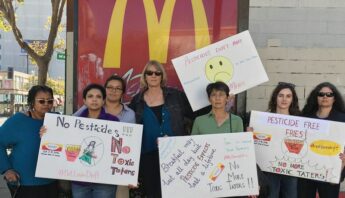Pesticide drift happens all too frequently, especially in rural California where homes, schools and agricultural fields can be nextdoor neighbors. Children — the most vulnerable members of these communities — are often the first to experience drift exposure and its resulting health impacts.
Pesticide drift happens all too frequently, especially in rural California where homes, schools and agricultural fields can be nextdoor neighbors. Children — the most vulnerable members of these communities — are often the first to experience drift exposure and its resulting health impacts.
Unfortunately, our regulatory process is so weak and broken that those responsible for drift too often get away with minor consequences, despite clear evidence of culpability and harm. This has to change. Now, after years of community pressure, California officials are finally considering measures that could protect schoolchildren from drifting pesticides. This is an important first step.
The case of Coachella Valley High
On October 1 last year students from Coachella Valley High School in California’s Central Valley were exposed to a mixture of pesticides that was applied during school hours on a neighboring lettuce field. When the wind changed direction, the applicator continued spraying and pesticides drifted into the school. Twenty-eight students and staff members experienced symptoms, including weakness, throat and eye irritation, headache, nausea, vomiting, dizziness, shortness of breath and coughing.
The Department of Pesticide Regulation (DPR) and the Riverside County Agricultural Commissioner investigated the incident. The lab analysis of environmental samples from the school were completed in two weeks time, but it took the regulatory agencies six months to finalize the investigation and issue a citation.
Yes, six months. The incident occurred in October 2015, and the citation was issued in April 2016.
In the end, the grower responsible for this incident, Amazing Coachella, Inc., paid a paltry $5,000 fine. While this is the top of the fine range for harm caused to a single individual, there were more than 25 individuals impacted in this case. Community members say $5,000 is a slap on the wrist for a grower as large as Amazing Coachella, Inc., which has farms in the Coachella Valley, Imperial Valley, San Jacinto, Bakersfield and Lancaster, and — according to their website — ships across the U.S. and Canada.
This is a story of justice not only delayed, but applied with a weak and puny hand. Enforcement like this can’t give much confidence to rural residents that their health is taken seriously by regulators.
A longstanding story of harm
Unfortunately this is hardly an isolated example. Over the years, we have reported often about pesticide exposure through drift, and the uphill task it is for communities to get redress for these harms, or influence pesticide application practices.
Stories of harm abound, from the 16 year delay in justice for students impacted in a pesticide drift incident in Rio Mesa High School in Oxnard to the documentation of cancer-causing pesticides drifting onto schools and nearby residences from strawberry fields in Watsonville. In Tulare county, biomonitoring found high pesticide levels in the bodies of residents living near orange groves.
Parents in Sonoma county are currently trying to protect schoolchildren from pesticide applications in neighboring vineyards. These kinds of problems were well documented across the state in a 2014 California Department of Public Health (DPH) report titled Agricultural Pesticide Use Near Public Schools. The DPH report showed that in the top 15 agricultural counties in the state more than 400,000 children attend school near fields where pesticides of public health concern are applied. So incidents like the one in Coachella can happen anytime in these counties, and past history has shown us they do.
Here’s Blaz Gutierrez, Directing Attorney of the California Rural Legal Assistance office in Coachella:
These incidents confirm what the community has known for generations. California should be on the forefront of providing a safe and healthy learning environment for all students, including Latino students in rural communities who have no refuge to turn to other than their school. These health risks are unacceptable and deserve immediate attention.”
A paradigm shift
Clearly, business as usual is harming generations of children and other members of rural communities. So what’s the solution?
Under pressure from rural residents across California, DPR is considering new regulations for pesticide applications around schools. Communities are asking for one-mile buffer zones where pesticides of public health concern will not be applied and adequate notification in the event of pesticide applications.
Eduardo Guevara, Executive Director of Promotores Comunitarios del Desierto, a community group from the Central Valley called for real changes in response to the Coachella incident:
. . . this is a clear call to review the best practices for applying pesticides in a way that they will not affect the surrounding areas (especially schools, medical facilities, or senior communities), to revisit the idea of buffer zones, and to make every effort possible to prevent this incident from repeating itself.”
Yes, we agree. All of us — growers, rural residents, scientists, regulators and advocates — must work together to ensure that our state remains a profitable agricultural state while at the same time protecting its children.
In the short term, we urgently need buffer zones and pesticide notification systems to protect the most vulnerable. But ultimately, a paradigm shift is needed — away from industrialized agriculture with its high pesticide inputs, and towards agroecological farming systems that not only protect health and the environment, but are also profitable and equitable. In an innovative state like California, this is doable.







